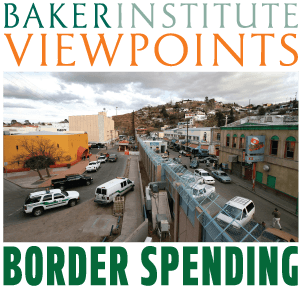In an effort to secure bipartisan support for immigration reform, a bill recently passed by the Senate includes a dramatic increase in border security spending of at least $40 billion. This funding provides for the addition of 18,000 new Border Patrol agents, 700 miles of fencing and expanded use of drones on the U.S.-Mexico border. Facing financial losses from the withdrawal of U.S. forces from Iraq and Afghanistan, the nation’s largest private military contractors are now vying for profitable contracts on the U.S.-Mexico border. Critics have argued that increasing border security spending will further militarize the border and exacerbate existing budget deficits. In this Baker Institute Viewpoints series, six experts respond to the question: What are the implications of expanding border security? Their analyses cover a range of issues — including the legality of drones, the environmental impact of constructing border fencing and the politics of bipartisan compromise — and reveal the complex unintended consequences of increasing spending on border security.
Read other posts in this series:
- Border security and (mis-)management by Tony Payan, fellow in Mexico studies and director of the Mexico Center
- U.S. border security spending: Too much, too late? by Robert Bunker, senior fellow with Small Wars Journal — El Centro
- The broader implications of enhancing border surveillance capabilities by Geoffrey Corn, professor at the South Texas College of Law
- Achieving border security: A matter of money or competency? by Guadalupe Correa-Cabrera, assistant professor and chair of the government department of the University of Texas at Brownsville
- Securing the “hyperborder”: U.S.-Mexico border security investments by John Sullivan, lieutenant in the Los Angeles County Sheriff’s Department and senior fellow with Small Wars Journal — El Centro
The Senate immigration bill provides a basis for the immigration debate in the United States. A key provision of the bill is an additional $46 billion for increased border security. While this level of spending will likely be included in the final compromise bill, it is not the best use of resources. As a recent Woodrow Wilson Center report argued, we have reached the point of diminishing returns on border security. Instead of trying to create an impenetrable wall at the border, we should use the resources to reinforce law enforcement in the nation’s interior, especially in border states, such as Texas.
There are unintended consequences to the Senate bill’s proposed expansion of border security. Following an increase in border security spending post-9/11, organized crime simply adapted to new security measures. The once-diffuse system of coyotes who smuggled individuals across the border for a small fee evolved into “polleros,” illicit networks that steal valid travel documents and rent them to migrants at high costs. These networks in turn must pay a fee to organized crime. In some cases, organized crime enters the business directly, given that enforcement efforts have made human trafficking highly profitable due to the necessity of coyotes and polleros. In this sense, increasing border security also increases the involvement of organized crime in the business of human trafficking.
The $46 billion for border security will be a boon for private military contractors, but will it be effective? There are no established metrics for border security. In fact, Congress had to call on the Department of Homeland Security to find metrics to determine when the “border is secure.” There is no consensus on how to define “secure.” Organized crime in Mexico in any case does not want a whiff of terrorism traced to the U.S.-Mexico border. Piggybacking on legal trade is its bread and butter. A terror attack linked to the border would shut that down and cut profits.
The last time the U.S. government increased the size of the Border Patrol this rapidly, there was also a significant increase in corruption. According to 2011 congressional testimony from Customs and Border Protection Commissioner Alan Bersin,
“Between FY 2004 and FY 2010, the U.S. Border Patrol more than doubled in size to a force today of more than 20,700 agents. … Since October 1, 2004, 127 CBP employees have been arrested or indicted for acts of corruption including drug smuggling, alien smuggling, money laundering, and conspiracy.”
How the money could be better spent:
1. Improve infrastructure at points of entry and increase customs personnel to facilitate legal trade. This will generate economic growth and increased tax revenues. Annual trade between the U.S. and Mexico is $500 billion. Some clear strategies for expanding trade include: reduced wait times at points of entry, increased bilateral trade, increased number of border-crossers and increased number of points of entry.
2. Fund interagency task forces to address identifiable problems that extend beyond the border. These problems include: human trafficking, gun smuggling, extortion, kidnapping, drug trafficking and the presence of transnational organized crime networks. Establishing task forces to address these issues may include additional Border Patrol hires, as they are valuable assets to interagency task forces.
We need to understand our strengths. The U.S. has strong law enforcement agencies at all levels. These agencies need increased coordination and funding for high-level investigations through interagency task forces. Resources should be spent on warrant-based wiretaps, cellphone tracking of kidnappers, additional agents to interview suspects’ family members and follow up on leads, as well as prosecutors to bring the cases to trial. Notice that this surveillance is in accordance with the Fourth Amendment to the Constitution. There is no required trade-off between security and liberty. Increased funding for these activities will be the real bulwark against “spillover violence” from Mexico, not a fantasy of an impermeable wall.
 Nathan Jones is the Alfred C. Glassell III Postdoctoral Fellow in Drug Policy at the Baker Institute. His areas of interest include U.S.-Mexico security issues, illicit networks and cross-border flows. Follow him on Twitter at @natejudejones.
Nathan Jones is the Alfred C. Glassell III Postdoctoral Fellow in Drug Policy at the Baker Institute. His areas of interest include U.S.-Mexico security issues, illicit networks and cross-border flows. Follow him on Twitter at @natejudejones.
